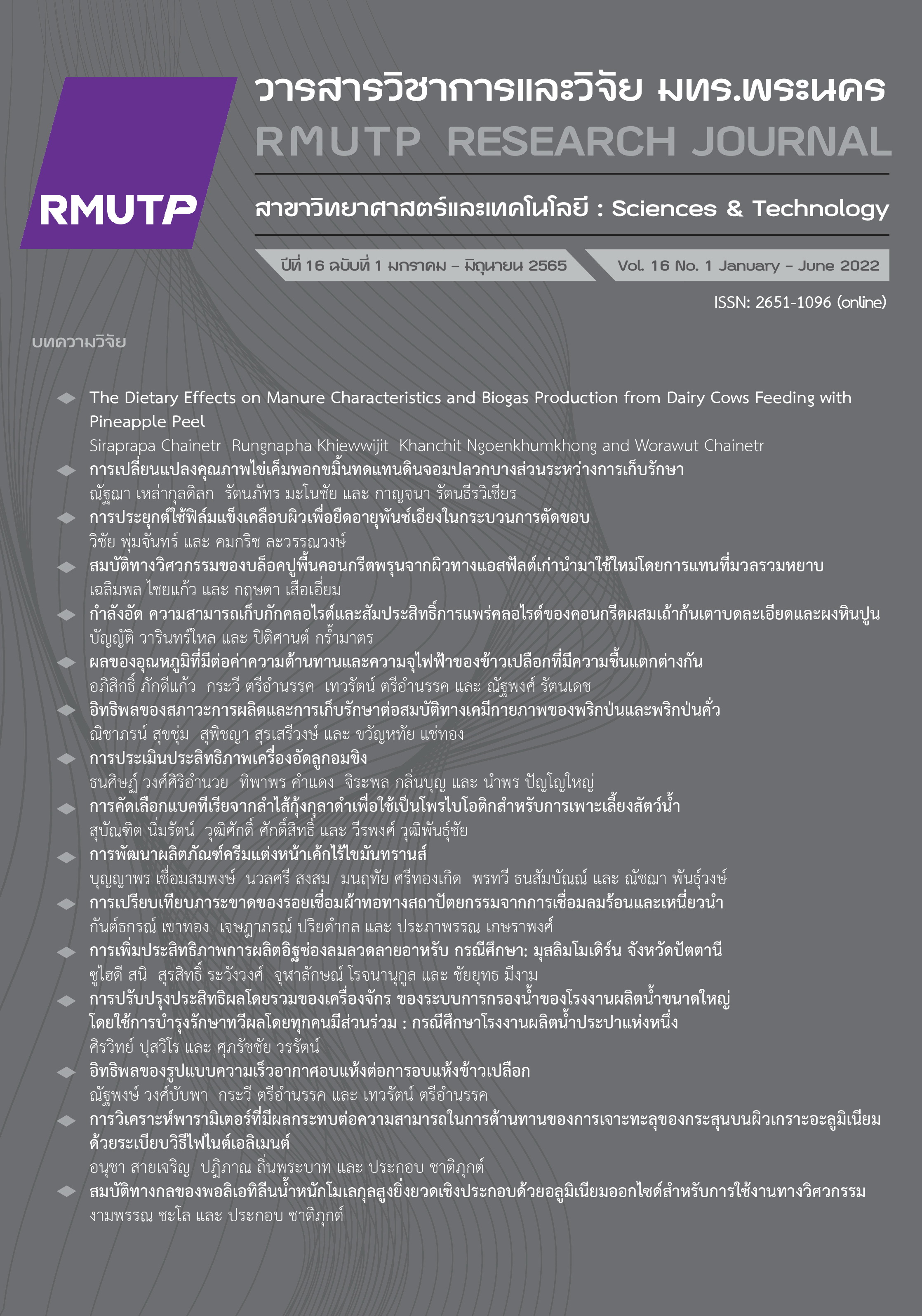The Application of Hard Film Coating for Extension Tool Life on Inclined Punch in the Trimming Process
Main Article Content
Abstract
The objective of this research is to increase the tool life of trimming process by surface coating technology. The procedure of this research consists of two sections. In the first section, the friction coefficient was investigated with the ball on disk technique by using a tribometer. Steel ball was produced from cold work tool steel grade SKD11 (JIS) hardened to 60±2 HRC. Two types of surface coating, namely AlCrN and TiAlN, were conducted by PVD technique. Disk material used in this experiment was made by stainless steel JIS; SUS 304 of 2 mm thickness. For the second section, the wear tests of trimming die were performed by using flat punch and inclined punch 45 degrees without surface coating as well as the inclined punch 45 degrees coated with AlCrN and TiAlN (PVD). Workpiece material used for the wear test was stainless steel JIS; SUS 304 of 2 mm thickness. Additionally, the finite element analysis was carried out for explanation the deformation of the workpiece during trimming operation. Although the friction coefficient of the surface coating was higher than non-coating, it could be extended the tool life ostensibly. As the result of FEM, the inclined punch 45 degrees could be generated the long sheared surface more than the flat punch. This is due to the internal stress of workpiece that did not connect from the punch to the die, so the crack propagation would be delayed. The inclined punch 45 degrees coated TiAlN has a highly durable which can be used up to 5,000 strokes.
Article Details

This work is licensed under a Creative Commons Attribution-NonCommercial-NoDerivatives 4.0 International License.
ลิขสิทธ์ ของมหาวิทยาลัยเทคโนโลยีราชมงคลพระนครReferences
G. Fang, P. Zeng and L. Lou, “Finite element simulation of the effect of clearance on the forming quality in the blanking process,” Journal of Materials Processing Technology, vol. 122, no. 2-3, pp. 249-254, Mar. 2002.
M. Sasada, H. Kobayashi and I. Aoki, “Study on piercing mechanism of small holes,” Journal of Materials Processing Technology, vol. 177, pp. 649-652, Jul. 2006.
S. Thipprakmas, M. Jin, K. Tomokazu, Y. Katsuhiro and M. Murakawa, “Prediction of Fineblanked surface characteristics using the finite element method (FEM),” Journal of Materials Processing Technology, vol. 198, pp. 391-398, Mar. 2008.
M. Farzin, H. R. Javani, M. Mashayekhi and R. Hambli, “Analysis of blanking process using various damage criteria,” Journal of Materials Processing Technology, vol. 177, no. 1, pp. 287-290, Jul. 2006.
K. Mori, Y. Abe, Y. Kidoma and P. Kadarno, “Slight clearance punching of ultra-high strength steel sheets using punch having small round edge,” International Journal of Machine Tools and Manufacture, vol. 65, pp. 41-46, Feb. 2013.
P. Chumrum, N. Koga and V. Premanond, “Experimental investigation of energy and punch wear in piercing of advanced high-strength steel sheet,” The International Journal of Advanced Manufacturing Technology, vol. 79, no. 5, Jul. 2015.
L. Komgrit and L. Pongsakorn, “FE Simulations and Experimental Analysis of the Blade Angle Effect on Sheared Surface in Trimming Process of Advanced High-Strength Steel Sheet,” Arabian Journal for Science and Engineering, vol. 44, Jun. 2019.
S.-H. Song and W. Choi, “FEM investigation on thermal effects on force in high-speed blanking of mild steel,” International Journal of Precision Engineering and Manufacturing, vol. 17, pp. 631-635, May 2016.
P. Pesch, S. Sattel, S. Woestmann, P. Masarczyk, K. Herden, T. Stucky, A. Martense, S. Ulriche and H. Hollecke, “Performance of hard coated steel tools for steel sheet drawing,” Surface and Coatings Technology, vol. 163-164, pp. 739-746, Jan. 2003.
K. Lawanwong, B. Sresomroeng and V. Premanond, “The study type of hard film coating and strength of materials to wear volume by Ball-on-disk technique,” Engineering Journal of Research and Development, Vol. 20, no. 4, pp. 84-91, Oct. 2009.
Ö. N. Cora, A. AĞCayazi, K. Namiki, H. Sofuoglu and M. Koç, “Die wear in stamping of advanced high strength steels – Investigations on the effects of substrate material and hard-coatings,” Tribology International, vol. 52, pp. 50-60, Apr. 2012.
J. A. Schey, Tribology in Metalworking: Friction, Lubrication, and Wear, 2nd ed. Metals Park, Ohio: American Society for Metals, 1984.


